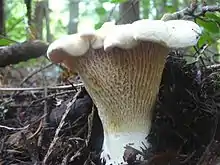Cantharellus subalbidus
Cantharellus subalbidus, the white chanterelle, is a fungus native to California and the Pacific Northwest region of North America. It is a member of the genus Cantharellus along with other popular edible chanterelles. It is similar in appearance to other chanterelles except for its cream to white color and orange bruising.[2]
| Cantharellus subalbidus | |
|---|---|
 | |
| Scientific classification | |
| Kingdom: | |
| Phylum: | |
| Class: | |
| Order: | |
| Family: | |
| Genus: | |
| Species: | C. subalbidus |
| Binomial name | |
| Cantharellus subalbidus | |
| Cantharellus subalbidus | |
|---|---|
float | |
| ridges on hymenium | |
| cap is infundibuliform | |
| hymenium is decurrent | |
| stipe is bare | |
| spore print is white | |
| ecology is mycorrhizal | |
| edibility: choice | |
C. subalbidus may form a mycorrhizal association with species of pine, hemlock, Douglas-fir, and Pacific madrone.[3][4][5] C. subalbidus has been found to be more common in old-growth forests than in younger forests.[6]
Similar species
Several other species of chanterelle may be found in western North America:
- C. californicus
- C. cascadensis[7]
- C. cibarius var. roseocanus
- C. formosus[7]
Additionally, Hygrophoropsis aurantiaca, Chroogomphus tomentosus, and species in the genera Craterellus, Gomphus, Omphalotus, and Polyozellus may have a somewhat similar appearance to C. subalbidus.
Uses
A choice edible, they can be prepared by being sautéed or cutting into chunks and baking at 350° Fahrenheit for 10 minutes.[7]
References
- Smith, A.H.; Morse, E.E. (1947), "The genus Cantharellus in the Western United States", Mycologia, 39 (5), pp. 497–534, doi:10.2307/3755192, JSTOR 3755192, PMID 20264537
- Plischke, J. (March 2004). "Cantharellus subalbidus: The white chanterelle". MushroomExpert.com. Retrieved 13 September 2010.
- Trudell, S.; Ammirati, J. (2009). Mushrooms of the Pacific Northwest. Timber Press Field Guides. Portland, Oregon: Timber Press. p. 45. ISBN 978-0-88192-935-5.
- Wood, Michael; Stevens, Fred. "California Fungi—Cantharellus subalbidus". mykoweb.com. Retrieved 14 September 2010.
- Arora, David (1986). Mushrooms Demystified: A Comprehensive Guide To The Fleshy Fungi (2nd ed.). Berkeley: Ten Speed Press. p. 662. ISBN 0-89815-169-4.
- Dunham, Susie M.; O'Dell, Thomas E.; Molina, Randy (2006). "Forest stand age and the occurrence of chanterelle (Cantharellus) species in Oregon's central Cascade Mountains" (PDF). Mycological Research. 110 (12): 1433–40. doi:10.1016/j.mycres.2006.09.007. PMID 17123812. Archived from the original (PDF) on 2011-08-14.
- Meuninck, Jim (2017). Foraging Mushrooms Oregon: Finding, Identifying, and Preparing Edible Wild Mushrooms. Falcon Guides. p. 5. ISBN 978-1-4930-2669-2.
External links
- Cantharellus subalbidus in Index Fungorum
- David Pilz; Lorelei Norvell; Eric Danell; Randy Molina (2003). "Key to Pacific Northwest CHANTERELLES, Chanterelle-Like Mushrooms, and Look-Alikes". Pacific Northwest Key Council. Retrieved 2011-03-22.